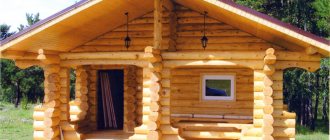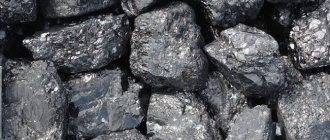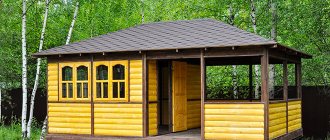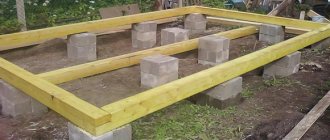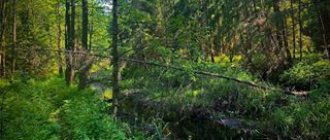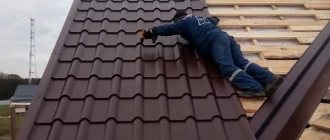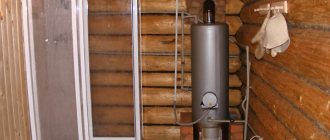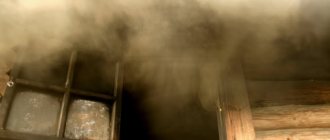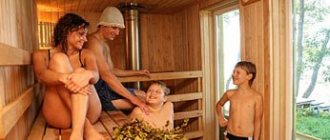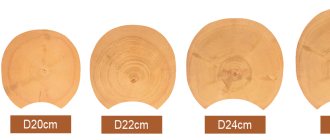In order for a wooden house to retain its original appearance, be reliable and attractive for many years, it is necessary to prepare it for long-term use. To do this, you need to go through all the required finishing stages, among which one of the main ones is treating the inside of a wooden house with special protective agents. Many owners of wooden log houses believe that if the structure is treated from the outside, treatment of the wooden walls from the inside of the house is not necessary; the wood already has reliable protection. However, this is not the case, despite the fact that indoors the wood is in more favorable conditions, however, it can also suffer from moisture, insects and other negative factors.
Primary processing of lumber usually takes place at the production stage. If you purchased untreated logs, you need to process them yourself before building the house. For this purpose, special transport impregnations are used; usually their validity period does not exceed eight months. Thus, these means provide protection for logs only during the construction period.
After construction is completed, the effect of the antiseptic has already expired, and the house remains unprotected. This is a very difficult period for a wooden house; it will have to go through a long process of shrinkage, which lasts from six months to two years. How to protect a log house during this period? At this time, a second protective treatment of the log house inside the house must be carried out. For re-processing, products are used that provide complete protection from any natural factors, but at the same time do not interfere with the air exchange and shrinkage processes taking place in the wood.
After the structure has undergone shrinkage, the main finishing work is carried out, including complex internal treatment of the wooden house with protective impregnating compounds. Then the treated log house can be painted, varnished, and decorated with decorative materials.
The above processing steps are suitable for a new home. As for old buildings, they must be treated at least once every five years.
Requirements for internal processing facilities
When choosing a composition for internal processing of imitation timber, eurolining, profiled timber or logs, criteria such as environmental friendliness and safety come to the fore. When choosing a drug, you need to carefully study its label. It should say on it that the product can be used for interior work. Many manufacturers indicate on the packaging detailed information about all the components included in the product.
What is the best way to protect the walls inside the house? For interior spaces, it is advisable to use water-based products. Such preparations usually have a neutral odor, do not contain toxic substances, and are safe for humans.
Harvesting time is the main secret of quality wood
The timing of forest felling played an important role in ancient times. Our ancestors believed that the durability of the finished structure depended on the correct timing for preparing the material. Coniferous trees were cut down mainly in winter. There were several reasons:
- people were free from work;
- it was believed that sleeping trees do not feel pain from an ax;
- trees cut down in winter had much less moisture, the buildings made from them were strong and durable;
- harvested trees were stored until spring without any problems; fungi and pests did not multiply under the bark.
December was considered the ideal time for cutting wood. Practice has shown that December wood was the most durable. However, some sources mention that material was also harvested in early summer and spring. In the spring, they mainly cut down deciduous trees; the bark was easily removed from them and, when dried in the sun, became hard and durable. The phases of the moon were also taken into account when choosing the time for harvesting logs. The best time was considered to be the waning moon phase.
Tags: process, log house, antiquity
« Previous entry
Indoor treatment products
How to cover imitation timber, logs, clapboard or any other lumber? There are several types of preparations designed to protect wood from various adverse factors. The products are transparent, not hiding the natural texture of wood, but, on the contrary, emphasizing its beauty. You can also impregnate wood with tinting compounds that give it a darker shade.
Wall treatment in a wooden house can be done using the following means:
- antiseptics;
- flame retardants;
- biopyrenes;
- primers;
- bleaching compounds.
This group of products is intended to protect a house made of timber or logs from fungus and mold, as well as combat existing lesions.
Antiseptics are available in two types:
- Impregnated compounds that are deeply absorbed into the wood, forming a barrier in it that prevents biological damage. These impregnations can be very toxic, so before purchasing a product, you need to study its composition.
- Coating preparations that create a film on the surface that protects the wood from water and dampness.
Antiseptics are produced on various bases, but only water-soluble and combined formulations are suitable for treating the internal surface.
Water-based impregnations are the most preferred option because they do not contain harmful components and are safe for humans. However, they have one significant drawback - their protective properties decrease after a relatively short period of time. It is advisable to use these products under water-soluble paints.
Combined preparations containing oils and high-carbon components are excellent for rooms with high humidity.
There is also a separate type of antiseptics - biomoisture protective, which protect wood not only from the appearance of mold and mildew, but also from the development of microorganisms and insects in its structure. This impregnation for a wooden house performs two functions at once: it protects the wood and creates a beautiful decorative coating on the surface.
Fire retardants
As you know, wood is very flammable and can ignite even from one spark. To avoid this, wood is treated with fire retardants. Wood impregnated with a fire retardant is highly resistant to fire and can not ignite for a long time even in the presence of an open flame.
There are two types of fire retardants:
- Saline. Preparations containing salts, when wood is heated strongly, release gases that prevent rapid ignition.
- Non-salt solutions block fire using foam, which forms on the surface under the influence of fire.
Biopyrenes
Biopyrenes are products that combine an antiseptic and a fire retardant. They provide protection from both biological factors and fire. These preparations can be used to cover the walls and floors of the house, and they can also be used for external treatment.
Biopyrenes are the best overall protection because they save not only money, but also processing time.
Primers
Before painting, applying a primer is mandatory. The primer is a good protection for wood from various destructive processes, and it also ensures optimal adhesion of paint to wood. For timber inside the house, it is recommended to use aqueous primers, which are transparent, translucent and opaque.
Please note that opaque primers provide a smoother surface. Transparent soils penetrate deeply into the wood without creating a protective layer on it.
If, during the shrinkage process, blue and dark spots appear on the interior walls of a wooden house, this indicates that a fungus has appeared in the wood structure, causing such manifestations. You can get rid of blue discoloration and fungal spores using special bleaching compounds.
In this case, many resort to folk remedies, such as bleach, hydrogen peroxide, and oxalic acid. These are simple and affordable drugs, but when used, there is a risk of misuse.
Today, modern industry produces the latest and very effective bleaches that provide a high degree of lightening and protection of wood. The products are produced in one- or two-component versions.
Treatment of wooden surfaces indoors begins with the lower elements of the house, which are more susceptible to moisture than others, since they are in close proximity to the ground. First of all, logs, subfloors, and lower floors are treated. Then they begin to process the main parts of the wooden structure: walls, ceilings, floors, partitions, etc.
Before processing wooden lining, timber or logs, it is necessary to prepare the surface. If the walls of the house have old paint, it must be removed. To do this, first the surface is heated until the paint softens, and then it is removed with a scraper.
Next, the wood is sanded and polished using a sander or grinder. Sanding is necessary for any lumber: logs, lining, imitation timber, etc. After sanding, the pores of the wood open, which better absorb processing agents.
An antiseptic is applied to a dry and pre-dusted surface. For interior spaces, one coat is sufficient. But for a bathhouse or an unheated house, one layer will not be enough. Such premises are treated twice.
The next treatment is carried out with fire retardant impregnation. It is better to coat the internal elements of the house with a non-salt fire retardant.
The last stage is priming the surface, after which any decorative coating can be applied.
accepts applications for professional processing of wooden houses. Protective treatment inside the house is carried out with certified preparations that are completely safe for humans.
You can check all the details of your order with our specialists at the coordinates located on the page.
Everyone knows that the majority of natural building materials, due to certain characteristics unique to them, require special processing and special operating conditions. Wooden building materials have many advantages, which is why they are very popular in the field of private construction. But not everything is as rosy as it seems at first glance; there are a number of properties that must be taken into account when building from this type of building materials.
A log house made from rounded logs requires time for shrinkage, as well as additional treatment with various compounds to preserve the appearance and properties of the wood.
For example, treating a log house made of rounded logs using various protective compounds is a mandatory condition, the fulfillment of which will determine the durability of the structure, as well as the attractiveness of its appearance.
The importance of tree protection
When choosing a log for a log house, you need to think about its durability in advance.
The fact is that different processing methods greatly affect the wood’s resistance to rotting:
- Rounded logs, compared to other types of round timber, are especially susceptible to moisture; their natural protection is practically negated during processing. The fact is that during calibration, not only the bark, but also a thick layer of dense wood is removed from the trunk;
Rounded round timber has minimal natural protection from moisture and insects
- But debarked logs lose only their bark; a protective layer of very hard wood remains. Impregnation is also needed here, but the durability of a log house made of such material will be higher. The only thing that may confuse you is the high price of debarked round timber compared to round timber;
Barked log is the best option for a log house
- Planed logs occupy an intermediate position between debarked and rounded logs.
Impregnating wood with antiseptics not only provides protection from rot and insects, but also reveals the texture of the wood. So you can apply a layer of clear varnish on top, and the wooden surface will already look good.
You can come across recommendations not to use impregnation at all for a log house, they say the round timber will be preserved perfectly as it is. But it’s better to treat the wood, at least to preserve its appearance, and the protection will be more reliable.
If the log is not treated, it will darken over time.
The choice of special compounds for treating wooden surfaces is very wide. For the most part, all popular antiseptics provide good protection against moisture and insects, the only thing is that you need to not confuse the means for external treatment and internal treatment. Indoors, compounds are usually used that do not release substances harmful to humans.
Treatment of logs on the inside is also necessary, although operating conditions will be more gentle than on the outside, but the humidity level can vary over a wide range, and you should not forget about insects.
As for the types of products used, the following types of solutions can be distinguished:
- easily washed out - as an example, saline solution can be used. This is too much of a budget option; it can only be recommended for processing auxiliary buildings and then as a temporary measure;
The saline solution can be used to treat surfaces that will not be exposed to rain.
- penetrating - treating rounded logs with this composition guarantees the penetration of the antiseptic to a decent depth (depending on the type of wood, but in most cases it will reach a depth of 5-7 mm). They do not wash out over time, and also allow the wood to breathe;
- film-forming - used rather to decorate the surface of the wood; the liquid does not penetrate deep into the wood. Such compositions are applied after impregnation with an antiseptic to give the desired shade to the wood.
To treat wooden surfaces inside the house, you can use, for example, SenezhAquadecor. It does not stain the surface of the wood, is absorbed deeply enough and does not create an impenetrable layer on the surface after drying, so the logs are not in danger of rotting from the inside.
One of the good options for interior work
Processing of a log house after installation of logs includes impregnation of rafter frames, as well as elements of wooden floors. Since they will not be visible, it is advisable to use compositions with coloring properties. This is done so that the treated and untreated areas can be clearly distinguished.
We suggest you familiarize yourself with How to polish a log house with your own hands
Antiseptics can paint wood a green tint, but the tint of the surface treated with a fire retardant is reddish. Of course, such compositions are not suitable for treating floors or ceilings.
The base of the rafter system is treated with an antiseptic with a green tint
External processing
Treating a log house with protective compounds on the outside gives much greater scope for creativity. At the same time, antiseptics can be used both as a prophylactic agent and for the preservation of existing defects.
When processing externally, you will have to solve several problems:
- carefully caulk the cracks and cracks in the logs;
- the ends of the logs are also processed (a separate compound is used);
- Only after this can you proceed to sanding the wall and applying antiseptic.
Wide and deep cracks in logs are far from uncommon; because of them, moisture and insects can easily reach the especially vulnerable central part of the log.
Fortunately, sealing cracks can be done with your own hands; for this you will need:
- clean the crack from dust and dirt;
- push the sealing material inside (there are special cords made of synthetic materials on sale). You can also use ordinary natural fabric;
The correct sequence of actions when filling joints and cracks with sealant
- then fill the rest of the crack with sealant; it is quite elastic, so when the house settles it will still provide a reliable connection between the edges.
Carefully filled joints and cracks look great
The question of how to treat the ends of logs is especially important because it is through the ends that the logs lose moisture at an accelerated rate. This is what causes cracks to occur. In addition, through the ends it is easier for moisture and insects to penetrate inside.
The photo shows an example of a careless attitude towards protecting logs
Usually the problem of how to process log sections is solved at the stage of harvesting round timber, but it is better to play it safe and process them yourself again.
We suggest you read: Why you can’t take a steam bath
To do this, you can use both folk and purchased remedies:
- The simplest recipe is to apply paraffin; this “chemical dead man” is guaranteed not to let moisture in;
Paraffin will preserve the original appearance of the end of the log
- You can also use purchased compounds, the same “Senezh TOR” does not contain substances harmful to humans, and treating log logs with an antiseptic at the ends normalizes the shrinkage of the log in the transverse and longitudinal direction.
If there are no particular problems with the question of how to treat the outside of a log house, then in the case of a wooden bathhouse you have to take into account the specifics of its operation. Experts are still inclined to believe that impregnation with an antiseptic from the inside is not necessary.
In this case, it is advisable to use debarked or planed logs with sufficiently high natural protection (meaning the content of resinous substances) as a building material. You just need to take into account that the use of tree species with a high resin content is unacceptable; due to the high temperature, the walls will be constantly sticky.
Recommendations for the use of different tree species
In principle, the instructions allow the processing of a chopped bath from the inside, but with a number of reservations:
- it is forbidden to use compounds that, when exposed to high temperatures, release harmful substances (that is, the lion's share of antiseptics is immediately eliminated);
- The wood must remain breathable.
If the problem of how to process the logs inside the bathhouse is perplexing, then you can try to limit yourself to external processing only. If the inside of the wood darkens a little after some time, you can simply sand the logs with a flap wheel; a pleasant shade of natural wood is guaranteed for several years.
Main grinding tool
If the bathhouse is built from inexpensive calibrated round timber, then external treatment is required. Considering that harmful substances have an unpleasant tendency to seep through wood and enter the air (especially at high temperatures), the product must be 100% harmless.
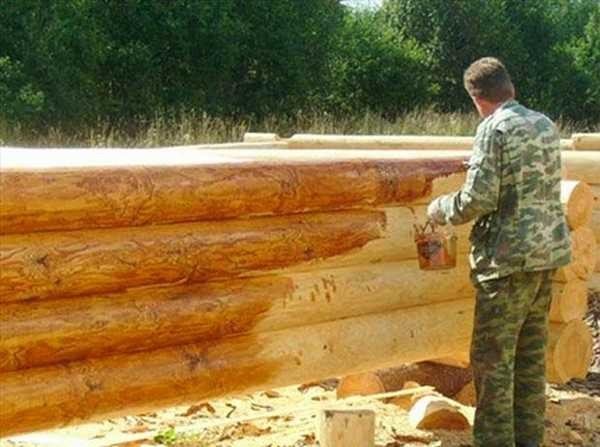
In principle, you can purchase logs already impregnated with a protective composition, but the question of how best to treat a rounded log in a bathhouse is still better to decide for yourself. The fact is that during factory impregnation, they don’t really think about the environmental friendliness of the antiseptic.
Any log structure must be covered with additional protection from the harmful effects of moisture, high temperature and steam inside, and from pests, snow, and rain outside.
In specialized stores, impregnations with a special composition suitable for wood processing are available for purchase.
Before choosing an antiseptic, you need to study their types, find out the features of their composition and application.
- Products with a composition that is easy to wash out are used for rest rooms and dressing rooms. Steam rooms cannot be used for processing, since they contain metal salts, which are quickly washed out of the wood.
- To treat the outside of a timber bathhouse, they use compounds that are difficult to wash out of the pores of the wood. They contain natural and synthetic oils.
- For steam rooms, fast-acting substances are used; they protect well from bark beetles, mold and mildew, and can withstand high temperatures.
We invite you to familiarize yourself with Assembling a sandwich pipe for a bath
Antiseptics are also divided into:
- Colored ones, which paint wood in a certain shade, are easy to apply and do not have any significant disadvantages.
- Colorless ones are more difficult to apply, but help preserve the original appearance of the wood.
Note. Treatment of a bathhouse made of timber from darkening inside is carried out using brushes, which are changed every 2 - 3 hours of operation. It can cover the entire bathhouse, but for large areas it is most convenient to use a spray bottle. This will allow you to apply the composition evenly and efficiently. Brushes are suitable for hard-to-reach places.
Processing methods
The following types of treatment for log baths are rarely used.
- Immersion method. The structural elements are completely lowered into the tank with the protective composition. It is considered the most effective, but quite expensive and labor-intensive.
- Dry or diffuse treatment using thick paste or powder.
- To reliably apply a protective coating to the material, it is necessary to treat the log house before collecting the crowns.
- Before processing, the log house must be cleaned of dirt using a vacuum cleaner.
- Check the logs for moisture; the material must be dry.
- A log bathhouse needs to be treated inside and out, because moisture can penetrate deep into the pores of the wood.
- The temperature in the bath before treatment should be low.
Some features
Due to moisture, a fungus can develop in the wood, which gives a recognizable change in the color of the wood - blue.
Let's consider, for example, a log house for a bath (sauna) made of rounded logs, which, due to its natural origin, has the property of low resistance to moisture.
Simply put, this building material absorbs moisture very easily, which means rot can form, which will contribute to the rapid deterioration of the logs. And the bathhouse, or rather its frame, will have a very short service life.
And all these factors, especially in combination, can at least spoil the appearance, and the most negative outcome will be the process of destruction of the structure. That is why wooden building materials must undergo timely special treatment using protective compounds intended for these purposes.
By using them, you can guarantee the durability and reliability of your home or bathhouse.
Return to contents
How to properly protect a log house?
Mandatory fire-prevention treatment of wood is carried out first.
If you seek advice from professionals, they will probably tell you a number of comprehensive measures aimed at achieving the durability of wooden building materials.
The high quality of wooden materials is achieved by following technology and carrying out complex processing at each stage of wood processing. The main ones are:
- logging stage;
- transportation stage;
- compliance with storage conditions;
- correct choice of location for future construction;
- creating a house or bathhouse project.
It should be recalled once again that experts believe that in order to keep the log house in perfect condition, processing of wooden blanks will be required at each of the above stages.
The stage that ends with the installation of a log house made of rounded logs requires its careful processing using protective compounds. They will help preserve and even increase the strength of building materials, reduce the degree of exposure of the tree to aggressive natural phenomena (such as humidity, for example), and also protect the log house from the growth of various bacteria and infections (fungus, mold, etc.).
In addition to the step-by-step protection of wood at all stages of its production and use, the use of chemical compounds for wood processing is very popular. The construction market is filled with various options, providing both antiseptic characteristics and the possibility of fire protection.
There are products that simultaneously combine several important properties listed above.
Treating the log house with an antiseptic is mandatory in any case.
Return to contents
Tools
The only tool for construction and wood harvesting was an axe. The saw has been known since the 10th century, but was used mainly by carpenters. The ax did not disturb the structure of the wood fibers, unlike the saw. With its help, they made cuts on the tree, removed the bark, and removed knots.
We suggest you read: How to properly install windows in a wooden frame - WikiPro: Industry encyclopedia. Windows, doors, furniture
The expression “cutting down a hut” came about precisely because of the widespread use of an ax at all stages of construction. In exceptional cases, a two-handed saw was used.
The main tool of labor in Rus' for the ancient architect was an ax. Saws became known around the end of the 10th century and were used only in carpentry for interior work. The fact is that the saw tears the wood fibers during operation, leaving them open to water. The ax, crushing the fibers, seems to seal the ends of the logs.
Stages of log processing: sequence and characteristics
If, after shrinkage of the log house, severe cracks and crevices appear in the wood, then treatment is carried out with special sealants.
Experts do not recommend carrying out work on processing a log house when its condition is considered damp and shrinkage has not occurred. An exception to this situation may be those surfaces of the log that, after installation, will be inaccessible and hidden in the structure of the log house.
In any other case, it is necessary to wait until the log house dries; its condition must correspond to the absence of natural moisture in it. This is due to the fact that excessive moisture content in building materials can make the penetration of the protective composition insufficient. As a result, you will not get the desired effect expected from their use.
The standard and most common type of treatment at the initial stage is the application of products whose action is aimed at protecting against fire. The next stage involves treatment with an antiseptic.
The action of fire retardants is due to the property that, upon contact with fire, allows the release of a special substance that prevents the flame from flaring up. Having carried out such treatment of the log house, you can be sure that if a situation arises when the wood is exposed to high temperatures, the fire-retardant properties will be activated, and the risk of fire will be reduced to a minimum.
As a result of this type of treatment, an atmosphere is created inside the tree that is not suitable for the life and reproduction of any insects. Fungus, bacteria and mold will also not be able to damage the structure you have built.
Thanks for the answer, but here's what I dug up: Flaxseed oil
is pure, cold-pressed linseed oil. When pressing flaxseeds, the temperature does not exceed 50 ºC.Flaxseed oil is a pure natural product, it is absorbed into the wood, protecting it from dirt, moisture and cracking. Linseed oil emphasizes the beautiful texture of wood and knots. Suitable in its natural form only for indoor use and for finishing wooden surfaces in contact with food products. Flaxseed oil is completely natural and environmentally friendly.
Consumption per planed surface
7-10 m2/l.
Places of application
of cutting boardswooden utensils
wooden Toys
furniture
wooden walls and ceilings
surfaces made of precious wood indoors
thermally treated wood indoors
Pre-treatment:
The wood material being processed must be dry, the maximum moisture content in the wood is less than 15% and the relative air humidity is less than 80%. First of all, clean old surfaces to remove varnishes, paints and other removable substances. Clean the remaining surface with sandpaper and wipe off sanding dust. User manual:Pine turpentine can be used as a thinner. Finish with a brush or cloth, applying a thin layer in the direction of the wood fibers and allow the oil to soak in. Excess oil that is no longer absorbed must be wiped off with a cloth no later than 1 hour. The wooden surfaces are sanded again and finished again. The number of finishing layers (1-4) depends on the quality of the wood surface and the purpose of use. Finish the end surfaces of the wood especially carefully. Flaxseed oil can be tinted with pigments. The dried wood surface can be finished by lightly sanding or scraping. The finished wooden surface can be waxed with wood finishing wax. New finishing is carried out if necessary every year. Linseed oil is not recommended for varnished or painted surfaces. Use for other purposes and contrary to recommendations is not recommended.
Drying time:
When applied with a brush in a thin layer, 24 hours (20 ºC).
Density:
0.93 kg/l.
Washing tools:
Water and soap solution.
Prevention of environmental risks:
Rags and wood shavings that come into contact with the product can catch fire on their own, so they should be kept moistened with water, kept in a closed tin container, or burned immediately before disposal. Empty and dry packaging can be destroyed along with other household waste.
Storage:
Can be stored in a cold warehouse.
Compound:
Flaxseed oil It will be a pity if it starts to rot from the inside. Maybe I'm wrong
To cut log houses from solid logs, use logs that have undergone primary selection in a cutting area (apiary). In the forest, they are sorted by curvature and diameter for each log house, bathhouse separately, depending on the size of the log house. Primary processing of the log is debarked, peeling the bark from the log trunk , is usually carried out in the forest, other methods of processing logs are carried out after removing the timber from the apiary.
Scraper treatment
For some log houses, logs are processed with a scraper (a semicircular tool is made of strong types of steel). The work is done only by hand. With this processing, a minimum layer of the upper part of the tree trunk is scraped off from the trunk of the logs. With this type of processing, the quality of the wood used for hand-cut log houses are not affected. A distinctive property of processing with a stapler is that unevenness on the log remains after processing. This type of processing is labor-intensive and expensive.
Processing logs with an electric planer
Logs for cutting houses and baths are processed with an electric planer; processing with an electric planer gives the log a look as close as possible to a rounded one; all knots and irregularities are planed, but the curvature of the log is preserved. A layer not exceeding 2-4 millimeters is removed from the trunk so as not to disturb the hardness of the wood being processed.
- Hardness is an indicator of the service life of the top layer of wood.
- The higher the hardness, the slower the wear.
This type of processing has become more popular than the one described above and is less expensive. In some cases, we carry out the processing with a plane directly at the customer’s site. The only drawback in this case is the removal of a large amount of chips.
Consequences of violation of round timber processing for a log house
Many of you have noticed, maybe someone has already encountered it, from the beginning of construction the log house of the house was beautiful without cracks in the logs, but after a while, cracks began to appear in the logs and were constantly increasing in size. These are the consequences of improper processing of the log; the top layer of wood was not planed wisely. In the logs, when they dry in the assembled well of the log house, cracks appear (this is a normal process of wood drying), but they are microscopic, and even one layer of paint or impregnation is enough to make them invisible. And such reasoning is that we will paint a log house in five layers and everything will be fine, maybe it will be beautiful, but there will be no fortress in this house.
Type of processing rounded log
Rounded logs have a number of advantages, more pronounced symmetry than that of hand-cut log houses made from logs (the rounded log is even, that is, the same diameter). There are more and more companies producing log bathhouses from rounded logs with a bottom groove for laying on the previous crown, in in the form of a complete ready-made set of parts - pieces of timber with bowls cut in the right places.
A kind of constructor, parts of the same diameter, a precisely cut bottom groove, simple markings make on-site assembly much easier and make construction much cheaper. All operations for the production of rounded logs are fully mechanized.
- But there are serious disadvantages of such processing - most of the sapwood is removed when sizing the log, which contributes to increased cracking and warping of the product, and uneven shrinkage.
- It is no longer possible to orient the north side of the log outward in the wall.
- A rounded log greatly loses in quality and durability, in relation to a hand-processed log, for the sake of decorativeness.
- And if the length of the wall of your house is more than 6 meters, then you will have several cuts inside (the maximum length of a rounded log is 6 meters)
In Russia at the moment there are enterprises that produce rounded logs of more than 6 meters, but the share of their output on the market is small. And we can cut hand-cut log houses from solid logs from a long wall of 11-15 meters.
Processing logs using the grinding method
Sanding a log can be done as when assembling a log house into a well, but this greatly delays the construction work. Sometimes this cannot be done due to weather conditions, for example in the fall, when work on grinding logs cannot be carried out, the logs are damp, then we carry out this work during the finishing work, that is, directly in the assembled well of the log house, bathhouse.
A wooden house is environmentally friendly and safe housing, and will always be popular. Natural wood, compared to other building materials, does not emit toxic hazardous substances, promotes the rapid exchange of oxygen in the room and simply has a pleasant forest aroma. In a wooden house there is always fresh air, it is warm in winter, and cool on hot summer days, a comfortable environment and cozy atmosphere will delight you for many years.
The ease of assembly of factory-made elements from logs or profiled timber significantly reduces installation time. Due to the relatively light weight of the walls of a wooden house, a deep, expensive foundation is not required. And also, thanks to the beauty and unique patterns of wood given to us by nature, the aesthetics of the materials does not require serious and expensive finishing.
Harvesting wood for construction
Trees in Rus' were especially revered, many of them were considered sacred.
Our pagan ancestors observed many rituals and superstitions regarding the tree. He was credited with power and strength and treated as a living being. The ancient Slavs approached the selection of suitable material with trepidation. Not all trees were allowed to be cut down; many of them were prohibited. The following could not be used for preparation:
- trees with anomalies: intertwined branches, forked tops, round growths;
- old or too tall trees;
- growing by the road, at crossroads;
- dry (lifeless) trees;
- young animals; (most likely this was due to the desire to preserve the forest);
- fruit and planted by man.
The most common species for logs were, and to this day are, coniferous trees. The ancestors already noticed their main features:
- strength and durability;
- smooth structure;
- correct trunk shape;
- no defects;
- ease of processing;
- minimum amount of moisture.
The huts and outbuildings made of coniferous trees stood for hundreds of years and practically did not deform or crack. Larch and pine were most often used for walls, and spruce for roofing. Deciduous trees were rarely used for construction, only in cases where no other species was available. These were birch, aspen, oak.
Before harvesting began, the ancient Slavs performed certain actions to increase durability and protect the wood from deformation. Trees were most often not cut down immediately. A few years before the start of harvesting, they did the following:
- We selected the wood in advance, made cuts and cut vertical stripes from top to bottom.
- Small areas of bark were left to allow the sap to flow.
- The tree was left for five years.
- After this time, it was completely saturated with resin, dried out and was suitable for further processing.
- With this approach, it was necessary to cut down the tree no later than December, before the days began to lengthen. Otherwise, it began to rot too early.
Trees selected for construction were sometimes watered at the roots with a sulfur solution to protect the material from aphid attacks. Watering was carried out for several years in a row.
When the right time came, the owner and the forester went into the forest. We discussed how much material was needed and where to cut it. For a standard quadrangular log house, about 100 logs 7 meters long were required. Suitable trees were selected by diameter, and the process of felling the forest began.
The tree was dug up from all sides and unnecessary roots were cut off. Some were left for convenience; it was easier to fell the tree: it fell slowly, and the roots that were left gradually broke off. With the help of wagons and ropes, trees were felled onto the snow. The snow cover protected neighboring plants from damage. Then all branches and roots were removed with an ax.
We invite you to familiarize yourself with: Frame bathhouse with a relaxation room
When all the trees of the required diameter were cut down, they were marked with notches. It was easier to keep score that way. The prepared logs were delivered to the construction site on horse-drawn sleighs. The bark was removed using an ax. The wood was first sorted and dried. Only then, in the spring, did they begin construction work directly. Men from all over the street participated in the construction process.
PROCESSING A WOODEN HOUSE OUTSIDE: SELECTION OF PRODUCTS AND STEP-BY-STEP INSTRUCTIONS
However, despite all the positive features, wooden houses also have a minus. Wood, as a natural material, is subject to negative environmental influences. Sun rays (ultraviolet), moisture in the form of precipitation, insects lead to the fact that the material can gradually darken and collapse. Mold, cracks and fungus may also appear, and the structure may subsequently lose its original appearance. But in the modern world, these problems can be avoided due to the necessary processing of the log house inside and outside using various means.
What else should you remember?
Along with this, when building your wooden house, you will also encounter many other issues that are no less important. However, all your efforts will be in vain if you do not take care of the antiseptic treatment of the wood of the structure, since the greatest damage to wood is caused by the smallest enemies - wood-staining and wood-destroying fungi, mold, mosses, lichens and insects - wood pests.
They are able to quietly become your neighbors and carry out destructive activities where you don’t even expect. Therefore, you should promptly take care of the health of your log house and use antiseptic agents for its comprehensive treatment. Compositions Neomid 400, Neomid 440, Neomid 430 Eco, Neomid 450 and wood bleach Neomid 500, etc. are well suited for these purposes.
WHY DO YOU NEED TREATMENT OF YOUR WOODEN HOUSE OUTSIDE?
- Protects wood from destruction;
- Retains the original appearance of a bathhouse or house made of logs or profiled timber for a long time;
- Prevents the appearance of fungus and rot;
- Prevents insects and moisture;
- Increases the service life of a wooden house or bathhouse;
- Improves the aesthetic qualities of logs; if necessary, you can change the appearance of the facade, obtain the desired color, shade or shine;
- Fire retardant treatment is mandatory for a log house, since fire is a significant threat to wood.
Table of end finishing products
| Name | Manufacturer | Properties |
| Senezh Tor | Russia | Good protection due to the penetration of the material several cm deep into the log house. It has the ability to allow air to pass through, but does not release moisture from the material. This means that the log house will dry as naturally as possible. Environmentally friendly product |
| Neomid Thor Plus | Russia | Forms a thin film on the surface of the log, which is water-repellent. Protects wood from cracks and putrefactive processes |
| Biotor | Russia | Thanks to the solution, the log will deform significantly less, since the product protects against dried cracks |
HOW TO CHOOSE PROCESSING PRODUCTS
Today, the market offers a lot of different products for treating wooden houses, both outside and inside. It is very important that the products you choose for processing are environmentally friendly and preserve the natural properties of wood. Also, the products must perform the protective functions of the tree from moisture, insects and other negative factors. Decorative properties are also of great importance. There are four main groups of products that will be needed to treat the outside of the house:
- Antiseptics are deeply absorbed into wood, increasing the resistance of wood to moisture and microbes. Antiseptic agents include wax, protective varnish and oils. They destroy mold and blue stains.
- Fire retardants prevent the spread of fire. At elevated temperatures, the composition of this product comes out and forms a protective film on the surface of the wood. This product prevents instant ignition and resists open fire for several hours.
- Preservative solutions and impregnations keep wood in good condition. Special impregnating materials maintain the smoothness and evenness of the wood surface and prevent cracks. And film-forming compounds additionally create a water-repellent barrier, which prevents the wood from absorbing excess moisture and, accordingly, prevents the creation of a damp negative environment in the wood. A primer or wood oil is suitable for these purposes.
- Protective and finishing agents are largely intended for decorating wood, in other words, for creating and long-term preservation of the aesthetic appearance of a house or bathhouse. These are paints and varnishes for wood. They protect the wooden surface from fading and dirt. There are also special bleaching compounds that will prevent the wood from darkening over time.
You should not choose one product that will immediately protect against mold and rot, insects and fire, while also performing decorative functions. Practice shows that such impregnations are not very effective and will not give the desired result. To achieve high-quality and durable results, it is better to use fire retardants, antiseptics and decorative paints and varnishes separately, since each of them will give a more significant effect in the area of its intended purpose.
and their characteristics
Brand Characteristic Price Senezh (Russia) Hard-to-wash high-class compounds in 20 types, including whitening and renewing compounds, antiseptics for baths, homes and gazebos; protect from fire, pests and moisture, provides protection for more than 10 years! from 380 rubles (5kg) Belinka (Slovenia) Natural and safe, highly effective products that protect against ultraviolet radiation, moisture, insects and fire, a wide range of products from 400 rubles (1l) Pinotex (Estonia) Polymer-based products protect against mold and moisture, fungus and insects, withstand sudden temperature changes, therefore optimal for external treatment from 280 rubles (1 l) Neomid (Russia) Effective impregnation for home, bathhouse and wooden floors, protects the surface from moisture for 5-7 years, special products are produced for processing ends, a good combination of price and quality from 200 rubles (1 l) Tikkurila (Finland) Moisture-resistant products, create a thin protective film and provide reliable protection from precipitation, are distinguished by high quality and positive reviews from 250 rubles (1 l) Aquatex (Russia) Available in the form of a primer and impregnation, colorless and tinted versions (15 colors), protects against fungus, ultraviolet radiation and moisture, suitable for middle-class wood from 200 rubles (1 l) Sitex (Russia) Suitable for any type of wood, protects logs from moisture , retains the appearance of the building for 10 years, colorless and tinted options (12 colors) from 200 rubles (1 l)HOW TO CORRECTLY TREAT THE OUTSIDE OF A WOODEN HOUSE
- Immediately after assembling a wooden house or bathhouse, it is necessary to treat it with antiseptics inside and out for the first time. We recommend paying special attention to the processing of ends and elements in contact with the foundation. Antiseptics must be applied in at least two layers;
- Primary processing cannot be carried out at temperatures below 10-12 degrees!;
- The next treatment is done after the log or timber has completely dried and the frame has completely shrunk. This takes 12 - 18 months if the wooden house was made from materials with natural moisture. This finishing involves the final complex and multi-layer processing of the house, which will ensure long-term protection of the log. It is also important to apply antiseptics to a dry and clean wood surface!;
- Before processing, additional grinding of the log or beam is necessary to remove the top layer, in which fungus and microbes may have accumulated during shrinkage. It will remove defects in the log and level the surface. Sanding wooden walls is absolutely necessary for an old house, since it is important to completely remove the previous coating;
- Processing with a brush will take a lot of time, but it will be of the highest quality, effective and durable. To speed up the process, spray guns are used. But for processing ends, corners and hard-to-reach places, take only a brush;
- First of all, antiseptic agents are applied in two or three layers. After drying, the wood is treated with fire retardants in one or two layers and also left to dry. The next layer is primer. It will protect the wood from cracks and level the walls;
- Carefully process the ends. These parts of the logs absorb moisture faster than others and are therefore more susceptible to rotting. To avoid this, each end treatment is done in 4-5 layers;
- The final stage is a decorative coating that will preserve the appearance of the house and protect the surface from sunlight. With the help of colored paints and varnishes, a certain color or shade, matte or glossy shine is achieved. If you want to preserve the natural color of the wood, use transparent paints and varnishes.
Chemical processing
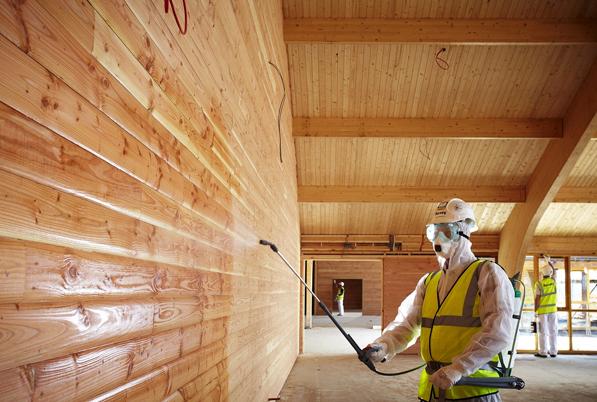
Most types of wood do not tolerate interaction well with water and even worse with hot steam, since it can penetrate much deeper into the wood mass and act many times more aggressively than ordinary dampness or moisture.
Innovative chemical production produces three main types of antiseptics. They are called “washable”, “difficult to wash” and “short-term”; they are used to treat cheap houses made of turnkey timber, as well as bathhouses.
The washable antiseptic substance consists of metal salts and is suitable for internal bath treatment. However, it is not designed for use in the washroom itself, since it is quickly washed out with water. It is advisable to treat dressing rooms and recreation areas with this composition.
Hard-to-wash products are used for external coating. They consist of various oils and synthetic substances. A bathhouse treated with hard-to-clean antiseptics is not susceptible to external aggressive influences.
The last version of the antiseptic is usually used at the time of formation of the log house. It is applied to floor joists, floors intended for ceilings and other elements of the bathhouse. The chemicals contained in short-term antiseptics prevent the formation of mold and mildew, reduce the risk of rot, and repel wood-boring beetles and other pests.
We must not lose sight of the fact that all these products belong to the category of chemically toxic substances. Therefore, they must be used carefully and carefully, since the bath always has a high content of moisture and steam, and its temperature reaches quite high levels.
Antiseptic containers must be labeled accordingly. You should purchase chemical protective equipment that is certified and in a special store.
WHAT AND HOW TO PAINT THE FRAME FROM THE OUTSIDE
Painting is the final stage of processing a log house outside and inside. Today there are a lot of different paints and varnishes. For exterior painting, choose rough and durable compounds. Let's consider the popular types of funds:
- Glazing transparent varnishes will retain color and emphasize the texture of wood, protect the surface from moisture, mold and rot;
- Opaque topcoat varnishes will help achieve the desired shine and shade, protect against insects, high humidity and ultraviolet radiation;
- Oil paints penetrate deeply into the structure of the log, keeping the surface from moisture and dirt. But they take a long time to dry (two weeks) and lose color over time!;
- Acrylic paints and water-based varnishes are natural, safe products that provide a dense, elastic coating. They protect against moisture, cracking and fungus. Such compositions allow the tree to “breathe”, but are expensive;
- Alkyd varnishes form a hard and smooth surface, retain color for a long time and provide protection from moisture. However, such products do not allow the wood to “breathe,” which over time causes the log to dry out and crack;
- Yacht varnish is suitable for places with high humidity and large amounts of precipitation. This is reliable protection against moisture, which is not affected by weather and temperature changes. This varnish does not fade and prevents yellowing of the wood, but when painted it emits an unpleasant odor;
- Stain is an affordable and cheap way to finish a log house inside and out. It protects against fungus and pests, does not disturb the wood grain and makes the color more saturated. However, stain requires subsequent varnishing;
- Oils and wax are environmentally friendly, safe products that are deeply absorbed into the wood and protect the logs from moisture and dirt. The wax will give the surface a translucent matte shine.
To properly paint a log house, wait until the primer is completely dry. Stir the mixture thoroughly before painting. First, paint is applied in two or three layers. Before applying each new layer, wait until the previous one is completely dry. Use a roller for painting, and a brush for hard-to-reach places, corners and ends.
When using a spray gun, it is not always possible to achieve an even and smooth coating. In addition, there may be unpainted areas. Apply the final coat of paint in a thin layer from top to bottom.
After the paint has completely dried, apply varnish in two or three layers. For an even coating without layering, allow each layer to dry and apply the product in long, even strokes. For decorative coating, you can use only varnish or only paint. However, the use of both means will consolidate the result and enhance the effect, enhance protection and increase the service life of the wood.
Special means for processing logs
First of all, it’s worth talking about the types of special impregnations that you can easily find in construction stores.
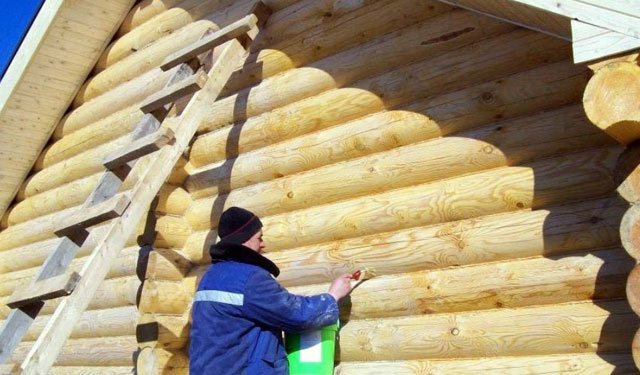
Impregnations are of the following types:
- Antiseptic agents are created to protect wood from the negative effects of moisture, for example, fungus and mold (more details: “Fungus in the bathhouse - how to get rid of it once and for all”). Such pests occur when moisture lingers for a long time on the wood and in its pores, so antiseptic impregnations penetrate deep into the wood structure and harden, preventing moisture from entering;
- Next, it’s worth talking about how to treat the log house of a bathhouse in order to protect it from fire. In this case, fire retardants will help you, which can be used indoors and outdoors. Their non-flammable composition also penetrates the pores of the wood and protects it;
- Complex impregnations are universal: they prevent the formation of mold and mildew, protect against rotting and fire. Such compositions are used outside and inside the log house.
